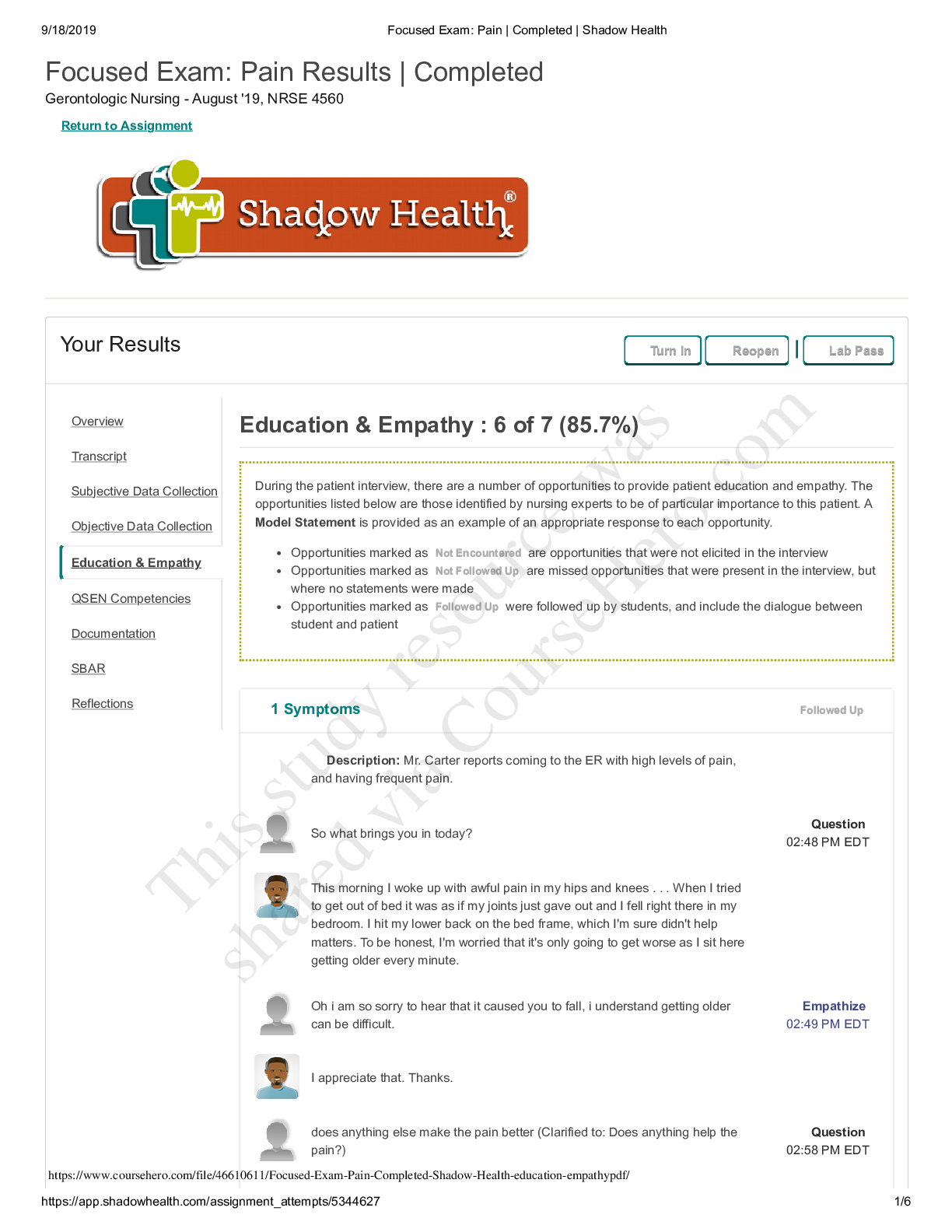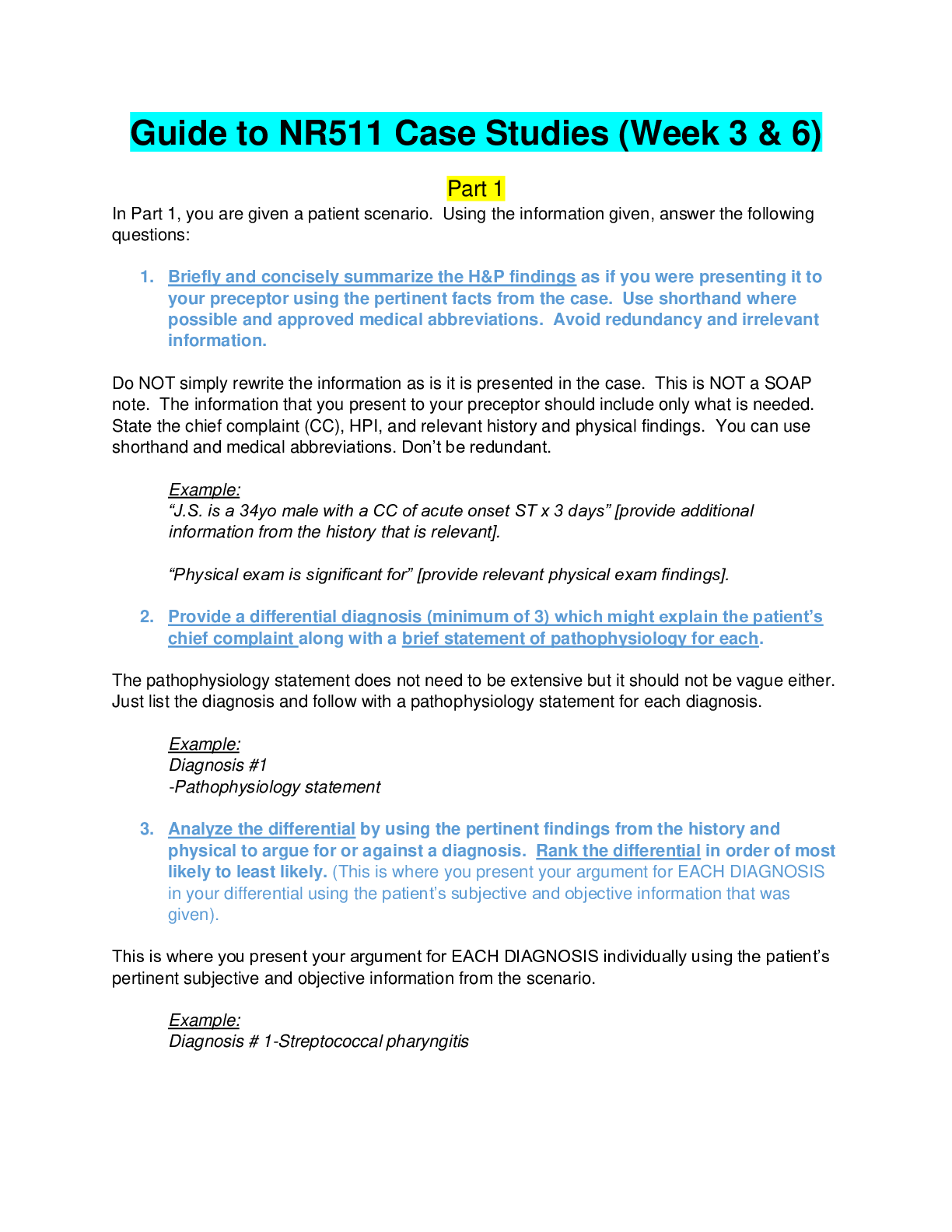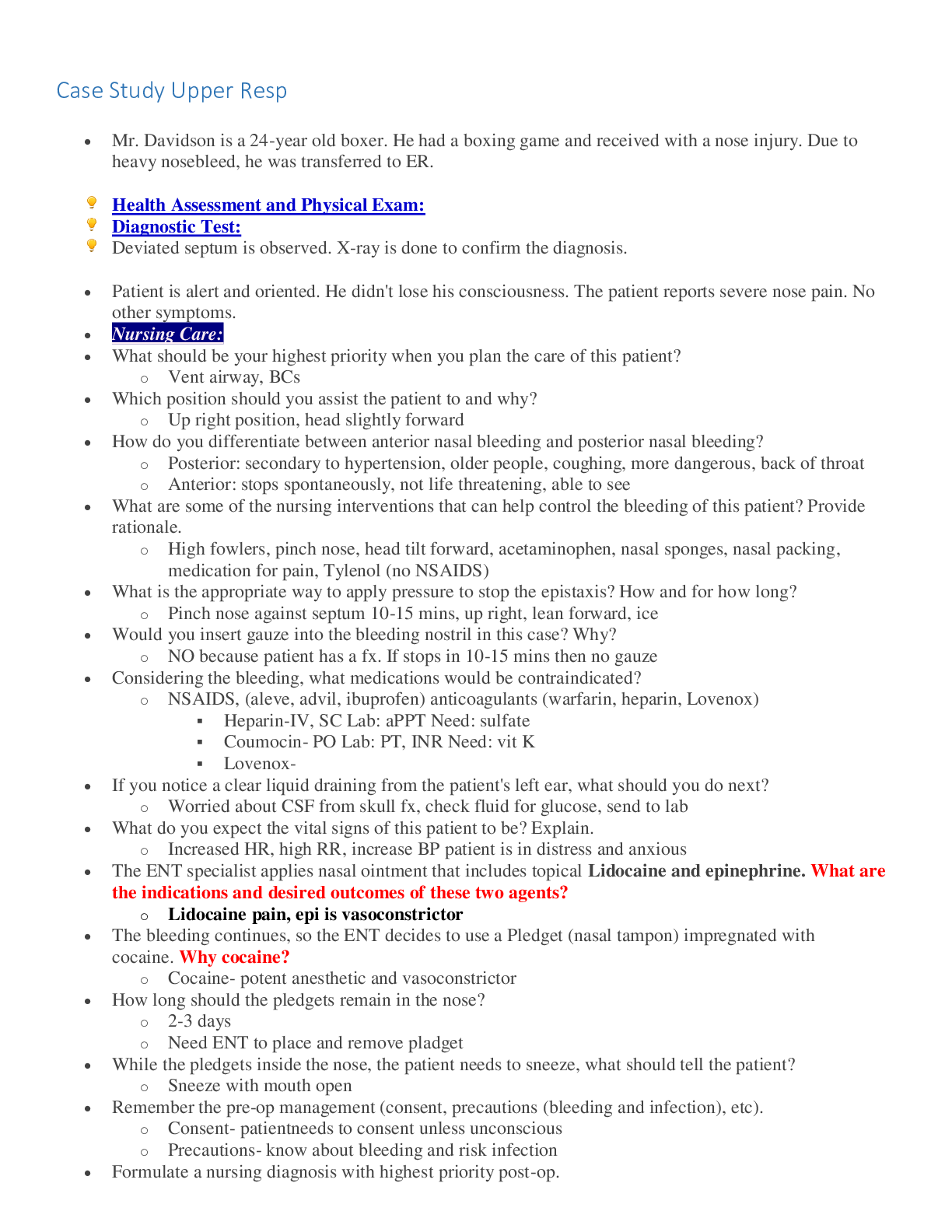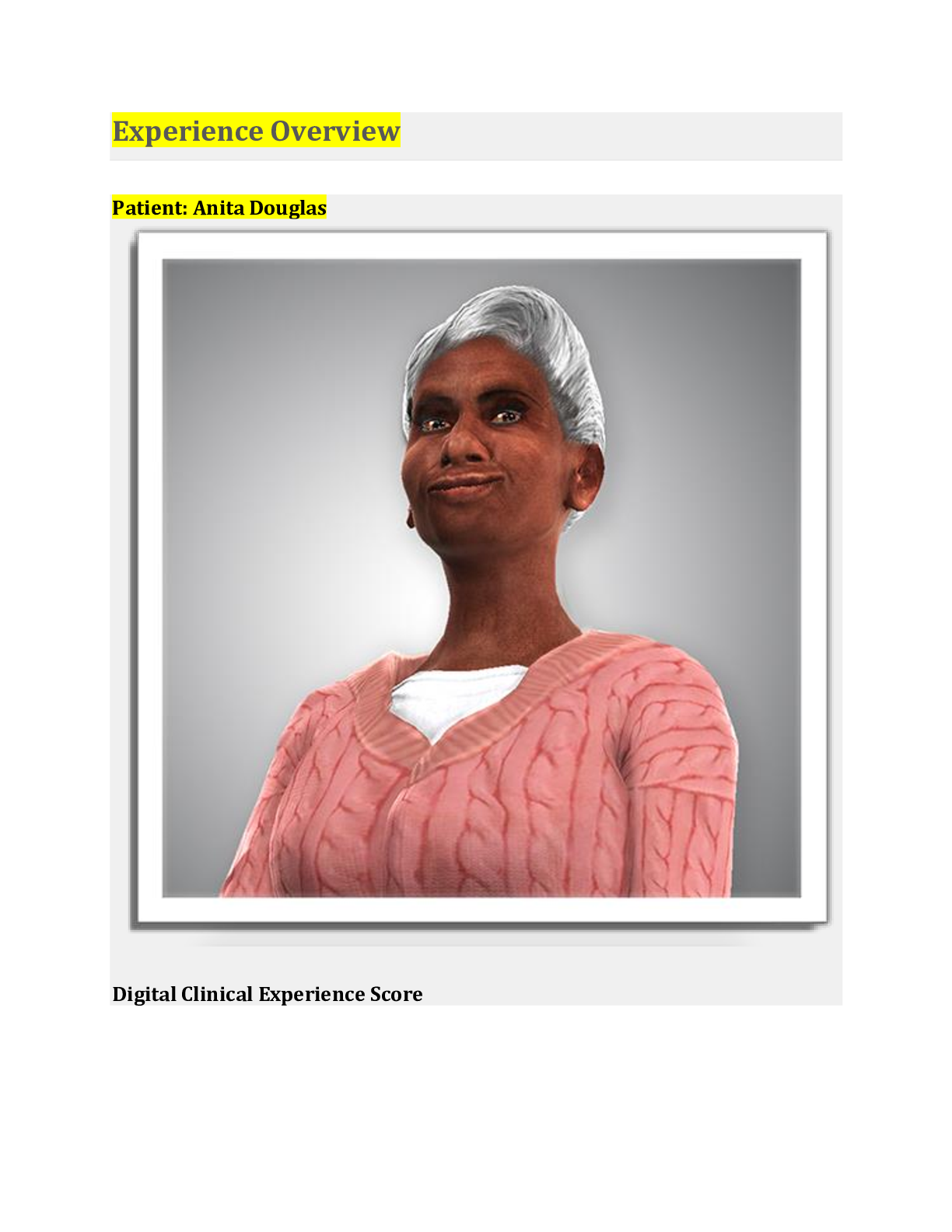*NURSING > CASE STUDY > NURS 6512 Review of Case study # 3, Case 1: Nose Focused Exam, Case 2: Focused Throat Exam (answered (All)
NURS 6512 Review of Case study # 3, Case 1: Nose Focused Exam, Case 2: Focused Throat Exam (answered) Verified (2020)
Document Content and Description Below
6512 Advanced Health Assessment. Wk5 The Assignment. Follow he Rubric. At least 3 matching References and citations. Use the Episodic/Focused SOAP Template and create an episodic/focused note ab... out the patient in the case study to which you were assigned using the episodic/focused note template provided in the Week 5 resources. Provide evidence from the literature to support diagnostic tests that would be appropriate for each case. List five different possible conditions for the patient's differential diagnosis and justify why you selected each. CASE STUDY 3: Focused Ear Exam Martha brings her 11-year old grandson, James, to your clinic to have his right ear checked. He has complained to her about a mild earache for the past 2 days. His grandmother believes that he feels warm but did not verify this with a thermometer. James states that the pain was worse while he was falling asleep and that it was harder for him to hear. When you begin basic assessments, you notice that James has a prominent tan. When you ask him how he's been spending his summer, James responds that he's been spending a lot of time in the pool. · RUBRIC Excellent Good Fair Poor Using the Episodic/Focused SOAP Template: · Create documentation or an episodic/focused note in SOAP format about the patient in the case study to which you were assigned. · Provide evidence from the literature to support diagnostic tests that would be appropriate for your case. 45 (45%) - 50 (50%) The response clearly, accurately, and thoroughly follows the SOAP format to document the patient in the assigned case study. The response thoroughly and accurately provides detailed evidence from the literature to support diagnostic tests that would be appropriate for the patient in the assigned case study. 39 (39%) - 44 (44%) The response accurately follows the SOAP format to document the patient in the assigned case study. The response accurately provides detailed evidence from the literature to support diagnostic tests that would be appropriate for the patient in the assigned case study. 33 (33%) - 38 (38%) The response follows the SOAP format to document the patient in the assigned case study, with some vagueness and inaccuracy. The response provides evidence from the literature to support diagnostic tests that would be appropriate for the patient in the assigned case study, with some vagueness or inaccuracy in the evidence selected. 0 (0%) - 32 (32%) The response incompletely and inaccurately follows the SOAP format to document the patient in the assigned case study. The response provides incomplete, inaccurate, and/or missing evidence from the literature to support diagnostic tests that would be appropriate for the patient in the assigned case study. · List five different possible conditions for the patient's differential diagnosis, and justify why you selected each. 30 (30%) - 35 (35%) The response lists five distinctly different and detailed possible conditions for a differential diagnosis of the patient in the assigned case study, and provides a thorough, accurate, and detailed justification for each of the five conditions selected. 24 (24%) - 29 (29%) The response lists four or five different possible conditions for a differential diagnosis of the patient in the assigned case study and provides an accurate justification for each of the five conditions selected. 18 (18%) - 23 (23%) The response lists three to five possible conditions for a differential diagnosis of the patient in the assigned case study, with some vagueness and/or inaccuracy in the conditions and/or justification for each. 0 (0%) - 17 (17%) The response lists two or fewer, or is missing, possible conditions for a differential diagnosis of the patient in the assigned case study, with inaccurate or missing justification for each condition selected. Written Expression and Formatting - Paragraph Development and Organization: Paragraphs make clear points that support well-developed ideas, flow logically, and demonstrate continuity of ideas. Sentences are carefully focused--neither long and rambling nor short and lacking substance. A clear and comprehensive purpose statement and introduction are provided that delineate all required criteria. 5 (5%) - 5 (5%) Paragraphs and sentences follow writing standards for flow, continuity, and clarity. A clear and comprehensive purpose statement, introduction, and conclusion are provided that delineate all required criteria. 4 (4%) - 4 (4%) Paragraphs and sentences follow writing standards for flow, continuity, and clarity 80% of the time. Purpose, introduction, and conclusion of the assignment are stated, yet are brief and not descriptive. 3 (3%) - 3 (3%) Paragraphs and sentences follow writing standards for flow, continuity, and clarity 60%–79% of the time. Purpose, introduction, and conclusion of the assignment are vague or off topic. 0 (0%) - 2 (2%) Paragraphs and sentences follow writing standards for flow, continuity, and clarity < 60% of the time. No purpose statement, introduction, or conclusion were provided. Written Expression and Formatting - English writing standards: Correct grammar, mechanics, and proper punctuation 5 (5%) - 5 (5%) Uses correct grammar, spelling, and punctuation with no errors. 4 (4%) - 4 (4%) Contains a few (1 or 2) grammar, spelling, and punctuation errors. 3 (3%) - 3 (3%) Contains several (3 or 4) grammar, spelling, and punctuation errors. 0 (0%) - 2 (2%) Contains many (≥ 5) grammar, spelling, and punctuation errors that interfere with the reader’s understanding. Written Expression and Formatting - The paper follows correct APA format for title page, headings, font, spacing, margins, indentations, page numbers, running heads, parenthetical/in-text citations, and reference list. 5 (5%) - 5 (5%) Uses correct APA format with no errors. 4 (4%) - 4 (4%) Contains a few (1 or 2) Readings Ball, J. W., Dains, J. E., Flynn, J. A., Solomon, B. S., & Stewart, R. W. (2019). Seidel's guide to physical examination: An interprofessional approach (9th ed.). St. Louis, MO: Elsevier Mosby. · Chapter 11, “Head and Neck” This chapter reviews the anatomy and physiology of the head and neck. The authors also describe the procedures for conducting a physical examination of the head and neck. · Chapter 12, “Eyes” In this chapter, the authors describe the anatomy and function of the eyes. In addition, the authors explain the steps involved in conducting a physical examination of the eyes. · Chapter 13, “Ears, Nose, and Throat” The authors of this chapter detail the proper procedures for conducting a physical exam of the ears, nose, and throat. The chapter also provides pictures and descriptions of common abnormalities in the ears, nose, and throat. Dains, J. E., Baumann, L. C., & Scheibel, P. (2019). Advanced health assessment and clinical diagnosis in primary care (6th ed.). St. Louis, MO: Elsevier Mosby. Credit Line: Advanced Health Assessment and Clinical Diagnosis in Primary Care, 6th Edition by Dains, J.E., Baumann, L. C., & Scheibel, P. Copyright 2019 by Mosby. Reprinted by permission of Mosby via the Copyright Clearance Center. Chapter 15, “Earache” This chapter covers the main questions that need to be asked about the patient’s condition prior to the physical examination as well as how these questions lead to a focused physical examination. Chapter 21, “Hoarseness” This chapter focuses on the most common causes of hoarseness. It provides strategies for evaluating the patient, both through questions and through physical exams. Chapter 25, “Nasal Symptoms and Sinus Congestion” In this chapter, the authors highlight the key questions to ask about the patients symptoms, the key parts of the physical examination, and potential laboratory work that might be needed to provide an accurate diagnosis of nasal and sinus conditions. Chapter 30, “Red Eye” The focus of this chapter is on how to determine the cause of red eyes in a patient, including key symptoms to consider and possible diagnoses. Chapter 32, “Sore Throat” A sore throat is one most common concerns patients describe. This chapter includes questions to ask when taking the patient’s history, things to look for while conducting the physical exam, and possible causes for the sore throat. Chapter 38, “Vision Loss” This chapter highlights the causes of vision loss and how the causes of the condition can be diagnosed. Note: Download the six documents (Student Checklists and Key Points) below, and use them as you practice conducting assessments of the head, neck, eyes, ears, nose, and throat. Ball, J. W., Dains, J. E., Flynn, J. A., Solomon, B. S., & Stewart, R. W. (2019). Head and neck: Student checklist. In Seidel's guide to physical examination: An interprofessional approach (9th ed.). St. Louis, MO: Elsevier Mosby. Credit Line: Seidel's Guide to Physical Examination, 9th Edition by Ball, J. W., Dains, J. E., Flynn, J. A., Solomon, B. S., & Stewart, R. W. Copyright 2019 by Elsevier Health Sciences. Reprinted by permission of Elsevier Health Sciences via the Copyright Clearance Center. Ball, J. W., Dains, J. E., Flynn, J. A., & Solomon, B. S., & Stewart, R. W. (2019). Head and neck: Key points. In Seidel's guide to physical examination: An interprofessional approach (9th ed.). St. Louis, MO: Elsevier Mosby. Credit Line: Seidel's Guide to Physical Examination, 9th Edition by Ball, J. W., Dains, J. E., Flynn, J. A., Solomon, B. S., & Stewart, R. W. Copyright 2019 by Elsevier Health Sciences. Reprinted by permission of Elsevier Health Sciences via the Copyright Clearance Center. Ball, J. W., Dains, J. E., Flynn, J. A., Solomon, B. S., & Stewart, R. W. (2019). Eyes: Student checklist. In Seidel's guide to physical examination: An interprofessional approach (9th ed.). St. Louis, MO: Elsevier Mosby. Credit Line: Seidel's Guide to Physical Examination, 9th Edition by Ball, J. W., Dains, J. E., Flynn, J. A., Solomon, B. S., & Stewart, R. W. Copyright 2019 by Elsevier Health Sciences. Reprinted by permission of Elsevier Health Sciences via the Copyright Clearance Center. Ball, J. W., Dains, J. E., Flynn, J. A., Solomon, B. S., & Stewart, R. W. (2019). Eyes: Key points. In Seidel's guide to physical examination: An interprofessional approach (9th ed.). St. Louis, MO: Elsevier Mosby. Credit Line: Seidel's Guide to Physical Examination, 9th Edition by Ball, J. W., Dains, J. E., Flynn, J. A., Solomon, B. S., & Stewart, R. W. Copyright 2019 by Elsevier Health Sciences. Reprinted by permission of Elsevier Health Sciences via the Copyright Clearance Center. Ball, J. W., Dains, J. E., Flynn, J. A., Solomon, B. S., & Stewart, R. W. (2019). Ears, nose, and throat: Student checklist. In Seidel's guide to physical examination: An interprofessional approach (9th ed.). St. Louis, MO: Elsevier Mosby. Credit Line: Seidel's Guide to Physical Examination, 9th Edition by Ball, J. W., Dains, J. E., Flynn, J. A., Solomon, B. S., & Stewart, R. W. Copyright 2019 by Elsevier Health Sciences. Reprinted by permission of Elsevier Health Sciences via the Copyright Clearance Center. Ball, J. W., Dains, J. E., Flynn, J. A., Solomon, B. S., & Stewart, R. W. (2019). Ears, nose, and throat: Key points. In Seidel's guide to physical examination: An interprofessional approach (9th ed.). St. Louis, MO: Elsevier Mosby. Credit Line: Seidel's Guide to Physical Examination, 9th Edition by Ball, J. W., Dains, J. E., Flynn, J. A., Solomon, B. S., & Stewart, R. W. Copyright 2019 by Elsevier Health Sciences. Reprinted by permission of Elsevier Health Sciences via the Copyright Clearance Center. Colyar, M. R. (2015). Advanced practice nursing procedures. Philadelphia, PA: F. A. Davis. Credit Line: Advanced practice nursing procedures, 1st Edition by Colyar, M. R. Copyright 2015 by F. A. Davis Company. Reprinted by permission of F. A. Davis Company via the Copyright Clearance Center. · Chapter 71, “Visual Function Evaluation: Snellen, Illiterate E, Pictorial This section explains the procedural knowledge needed to perform eyes, ears, nose, and mouth procedures. Sullivan, D. D. (2019). Guide to clinical documentation (3rd ed.). Philadelphia, PA: F. A. Davis. · Chapter 2, "The Comprehensive History and Physical Exam" (Previously read in Weeks 1, 3, 4, and 5) Bedell, H. E., & Stevenson, S. B. (2013). Eye movement testing in clinical examination. Vision Research 90, 32–37. doi:10.1016/j.visres.2013.02.001. Retrieved from https://www.sciencedirect.com/science/article/pii/S0042698913000217 Rubin, G. S. (2013). Measuring reading performance. Vision Research, 90, 43–51. doi:10.1016/j.visres.2013.02.015. Retrieved from http://www.sciencedirect.com/science/article/pii/S0042698913000436 Harmes, K. M., Blackwood, R. A., Burrows, H. L., Cooke, J. M., Harrison, R. V., & Passamani, P. P. (2013). Otitis media: Diagnosis and treatment. American Family Physicians, 88(7), 435–440. [Show More]
Last updated: 2 years ago
Preview 1 out of 10 pages
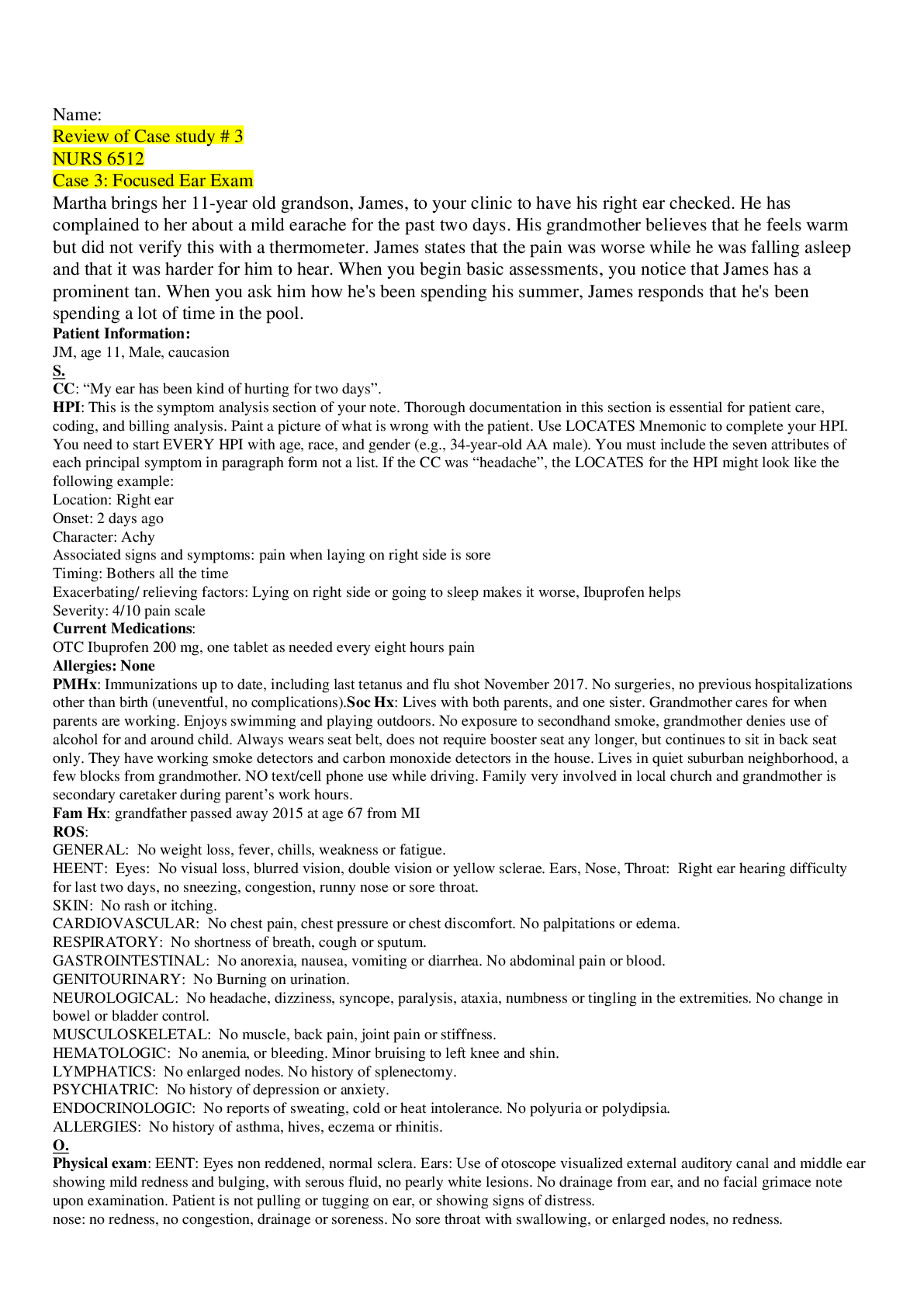
Buy this document to get the full access instantly
Instant Download Access after purchase
Buy NowInstant download
We Accept:

Reviews( 0 )
$16.00
Can't find what you want? Try our AI powered Search
Document information
Connected school, study & course
About the document
Uploaded On
Jun 29, 2020
Number of pages
10
Written in
Additional information
This document has been written for:
Uploaded
Jun 29, 2020
Downloads
0
Views
104





